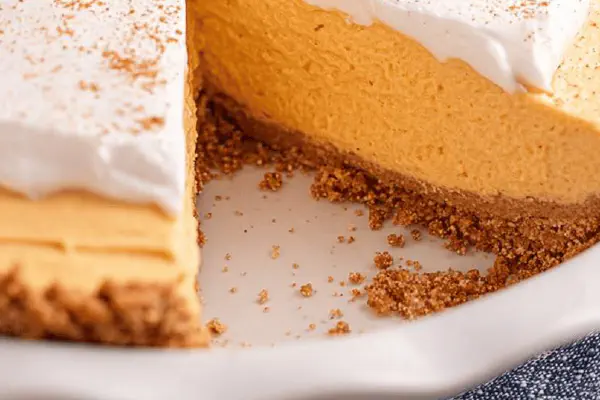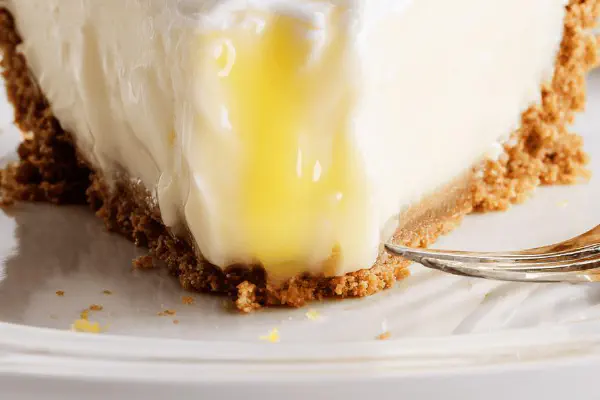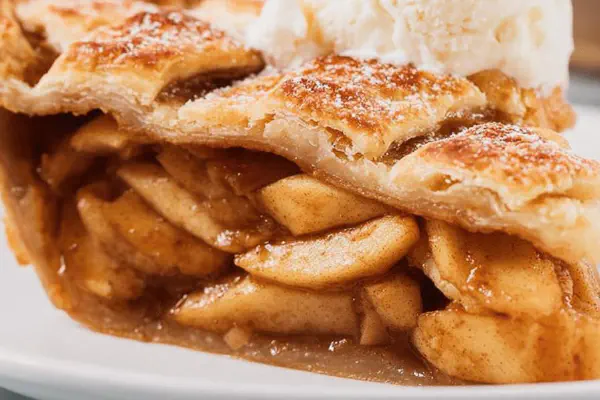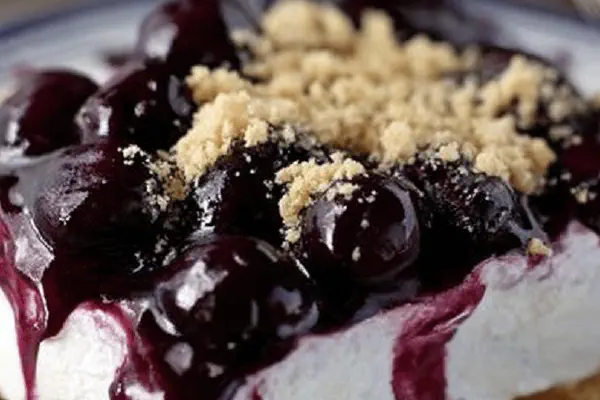Pumpkin Mousse Pie Remix

By Emma
Certified Culinary Professional
Ingredients
- 9-inch pie dish, lightly sprayed with non-stick cooking spray
- 250g digestive biscuits (or graham crackers as alternate)
- 110g unsalted butter, melted
- 50g coconut sugar (sub brown sugar)
- 225g cream cheese, softened
- 425g pumpkin puree (canned or fresh and cooked)
- 75g brown sugar
- 1 tsp vanilla extract
- 1 tsp pumpkin pie spice plus 1/4 tsp ground cardamom (optional for twist)
- 4 cups whipped cream or whipped topping, divided
- Ground cinnamon, for garnish
About the ingredients
Method
- Pulse the digestive biscuits in a food processor for about 30 seconds until crumbly and mostly fine but with a few slightly bigger bits that add texture.
- Add melted butter and coconut sugar to crumbs; pulse just until mixture feels like wet sand — too wet make crust soft; too dry, it won’t pack well.
- Press crumb mixture firmly into the bottom and about halfway up sides of prepared pie dish. Use damp fingers or a flat measuring cup bottom to compact well. Visual cue: edges even, no loose crumbs.
- Cover loosely with plastic wrap and freeze crust while you prep mousse. Freezing before filling crucial to stop sogginess later.
- In stand mixer bowl or with hand mixer and whisk, combine cream cheese and pumpkin puree on low speed. Stop when fully blended but watch for lumps; scrape sides.
- Add brown sugar, vanilla, pumpkin pie spice, and cardamom if using. Mix gently on low until mousse smooth and uniform. Avoid overmixing here or you’ll lose air potential.
- Fold in 2 cups whipped cream with a rubber spatula carefully. No rushing; want light airy texture but mousse still holds shape. Overfold and it’ll deflate.
- Pull the frozen crust from freezer. Should be firm to touch, slightly frosty but not icy.
- Spoon mousse into crust, smoothing top with spatula or back of spoon. No air pockets; mousse should sit evenly.
- Cover tightly with plastic wrap and refrigerate at least 6 hours, ideally overnight. Don’t rush this stage; mousse firms up, crust absorbs moisture just enough without going soggy.
- At serving, spread remaining 2 cups whipped cream on top. Generous but neat layer. Dust with cinnamon for aroma and bite contrast.
- If digestive biscuits unavailable, substitute graham crackers but reduce sugar slightly; grahams are sweeter.
- Use room temperature cream cheese to avoid lumpy filling. Cold will give you that uneven texture; patience to soften pays.
- If mousse too runny after folding whipped cream, refrigerate longer; cold traps air bubbles making texture set. If still not firm, add a tablespoon of instant vanilla pudding mix next time.
- Storing leftover pie tightly covered in fridge; best eaten within 2 days for freshest texture.
- Watch your whipped cream brand; some stabilize better. If homemade, whip cream to soft peaks, not stiff or you’ll get a dense mousse.
Cooking tips
Chef's notes
- 💡 Pulse digestive biscuits until mostly fine but leave small bits for texture contrast. Fine crumbs pack better but total powdery crust fails. Butter amount controls moisture; too wet means soggy crust. Freeze crust after pressing to lock shape. Cold crust resists sogginess under mousse weight. Use fingers or flat tool to compact firmly. Visual check edges no loose crumbs. Texture here makes or breaks base.
- 💡 Cream cheese must be softened fully before mixing. Cold clumps ruin mousse texture; microwave short bursts if rushed but stir well. Low speed blending to avoid overworking. Watch for lumps, scrape sides for uniform. Spices added now mix gently, preserve air pockets in mousse later. Whipped cream folding is delicate; rubber spatula, slow lifts from bottom to top. Overfold spills air, underfold means uneven mousse body.
- 💡 Coconut sugar swap changes caramel notes. Less sweet than brown sugar, blends smoother in crust and filling. Adjust sugar if using graham crackers instead of digestives; grahams sweeter, use less sugar to balance. Cardamom adds bright floral hint; skip if unsure but worthwhile for nuance. Whipped topping can replace cream cream but check brands; stabilized stuff holds air better, homemade needs soft peaks, not stiff peaks.
- 💡 Freeze crust before mousse fill really critical. Avoids soggy bottom traps moisture if simply refrigerate. Mousse needs long chill; minimum 6 hours to firm. Visual clues: mousse glossy, thick but slightly wobbly. Firmness develops cold, patience vital. Cover tightly with plastic wrap to block fridge odors. When topping with remaining whipped cream, apply thin even layer to avoid overwhelming mousse texture.
- 💡 Watch whipped cream brands. Some collapse faster. Homemade whip soft peak stage holds best with mousse fold. Mousse too runny after folding means chilled longer or next batch add instant vanilla pudding mix teaspoon for structure. Crust melts easily with room temp butter; melt slowly low heat or microwave bursts. Brown butter flavor changes crust profile - control heat carefully. Digestive biscuit crumbs replaced by graham crackers? Lower sugar quantity for sweetness balance.
Common questions
Can I substitute graham crackers for digestive biscuits?
Yes but grahams sweeter so reduce sugar. Texture slightly softer. Mix carefully adjust sugar. Biscuit crumbs can be pulsed in plastic bag with rolling pin if no processor.
How to avoid soggy crust?
Freeze crust before filling. Crust must feel cold, firm but not icy. Press crumb mixture tightly. Butter moisture balance key; too wet = soggy. Cover tightly during refrigeration.
What if mousse is too runny?
Chill longer first, traps air bubbles firming mousse. If still loose, folding technique may have overmixed air. Next time add a spoon vanilla pudding mix to stabilize. Use room temp ingredients, fold whipped cream slowly, no rush.
How long keep leftovers?
Best eaten within 2 days. Keep pie tightly wrapped to avoid fridge odors. Can freeze but texture may change; thaw slowly in fridge overnight. Mousse quality drops after multiple temperature changes.



